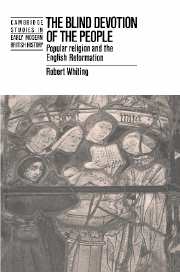Book contents
- Frontmatter
- Contents
- List of illustrations
- Preface
- Note
- 1 Introduction
- 2 Survey
- PART ONE ASSESSMENT
- 3 Dependent activities: sacraments, ceremonies and intercessions
- 4 Independent activities: prayers, images and cult objects
- 5 Inclusive institutions: parish churches, chapels and guilds
- 6 Exclusive institutions: papacy, religious orders and secular clergy
- 7 Summation of Part One
- PART TWO EXPLANATION
- Appendix 1 Maps
- Appendix 2 Graphs
- Bibliography and abbreviations
- Index
3 - Dependent activities: sacraments, ceremonies and intercessions
Published online by Cambridge University Press: 11 December 2009
- Frontmatter
- Contents
- List of illustrations
- Preface
- Note
- 1 Introduction
- 2 Survey
- PART ONE ASSESSMENT
- 3 Dependent activities: sacraments, ceremonies and intercessions
- 4 Independent activities: prayers, images and cult objects
- 5 Inclusive institutions: parish churches, chapels and guilds
- 6 Exclusive institutions: papacy, religious orders and secular clergy
- 7 Summation of Part One
- PART TWO EXPLANATION
- Appendix 1 Maps
- Appendix 2 Graphs
- Bibliography and abbreviations
- Index
Summary
In the parish church at Doddiscombsleigh, fifteenth-century stained glass portrays the key rites of the pre-Reformation Church. Each of the seven panels is linked by a crimson line to the wounds of a central figure of Christ. The message is unmistakable. Through the rites of his Church, as administered by his priests, the Lord conveys his life to the believing community.
Among the most crucial of these were the rites of passage, performed at the principal crisis points of human existence. The birth of a child was followed within days or even hours by its presentation for baptism. The glass at Doddiscombsleigh shows priest and infant at the font; an acolyte holds the service-book, and parishioners assemble to witness. According to a Cornish play of 1504, the waters of baptism removed original sin; they thus procured admission to the believing community. This belief explains the anxiety of parents to secure the rapid baptism of their new-born, as, for example, at Wembury in about 1535. Within a few years, moreover, the child would receive the sacrament of confirmation – usually, as is depicted at Doddiscombsleigh, from the bishop himself. Progressing to adulthood, he usually experienced the sacrament of marriage. At Doddiscombsleigh the hands of bride and groom are ritually linked by the officiating priest. Inevitably there was provision also for the ultimate crisis of human life. At Doddiscombsleigh a dying man receives the last rites from his priest; the latter holds a paten and is accompanied by acolytes.
- Type
- Chapter
- Information
- The Blind Devotion of the PeoplePopular Religion and the English Reformation, pp. 17 - 47Publisher: Cambridge University PressPrint publication year: 1989



